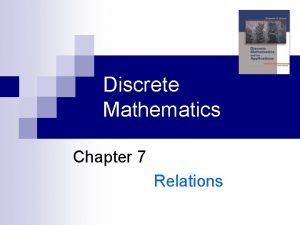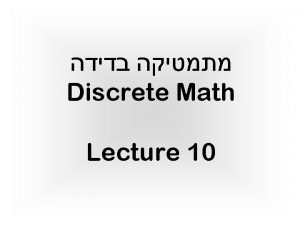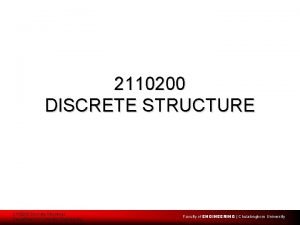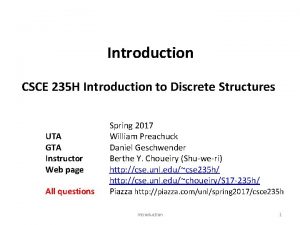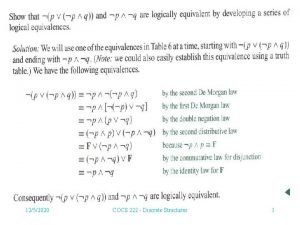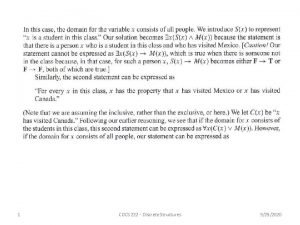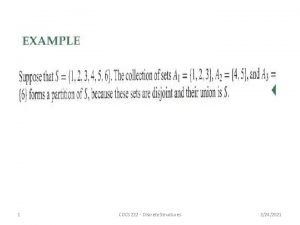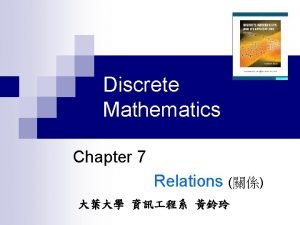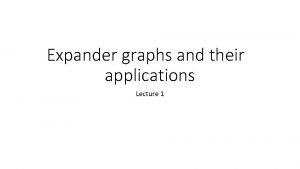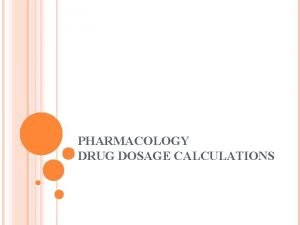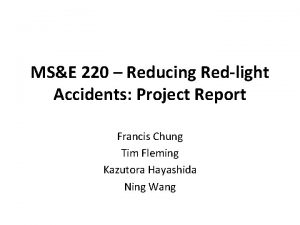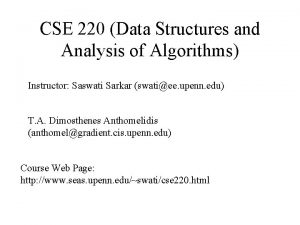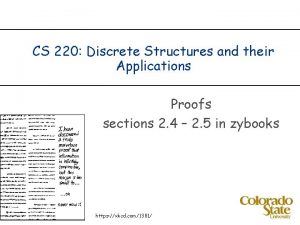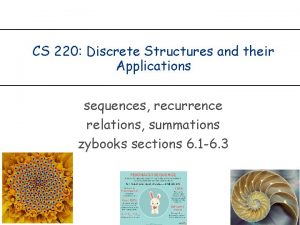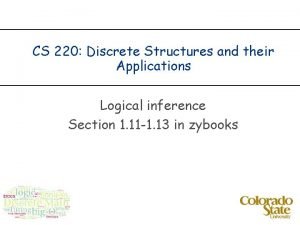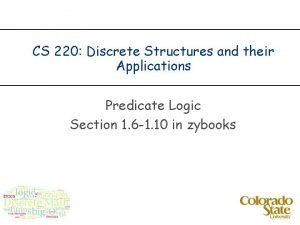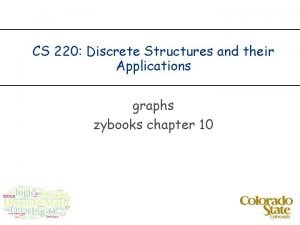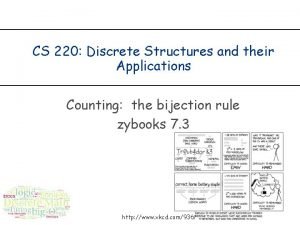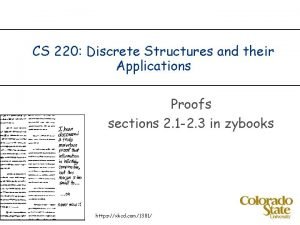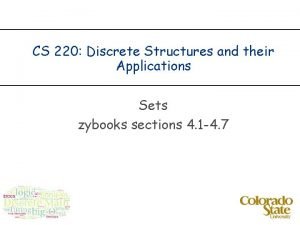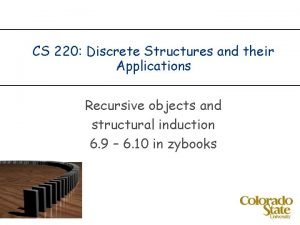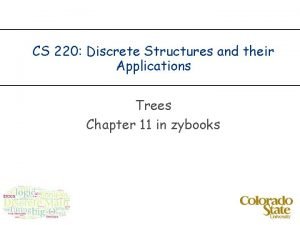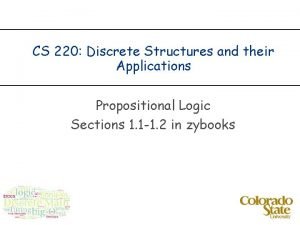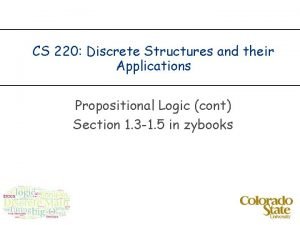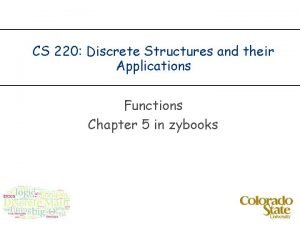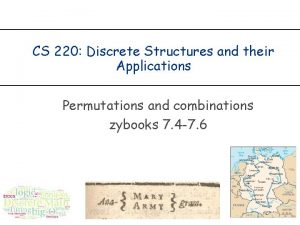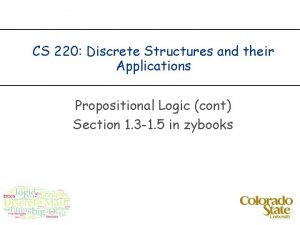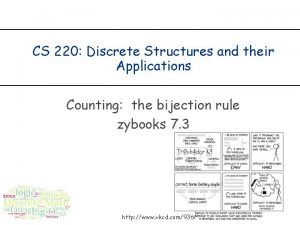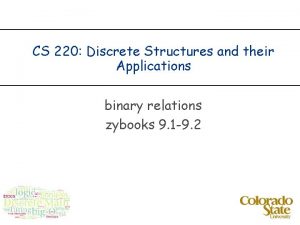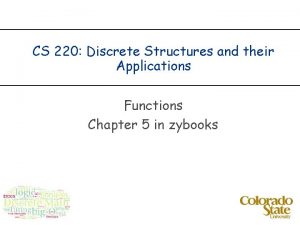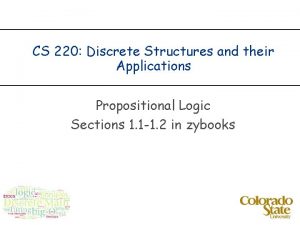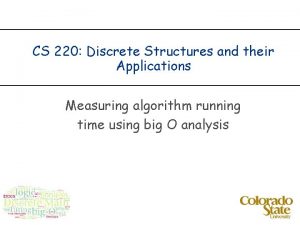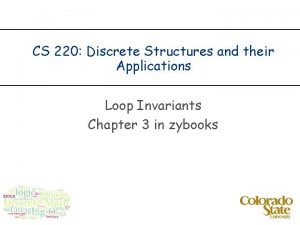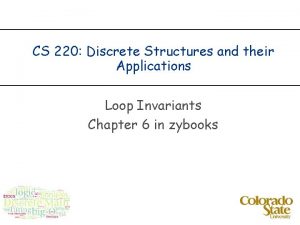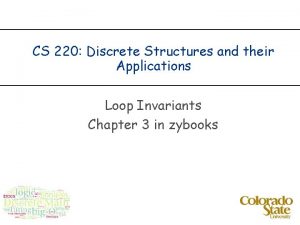CS 220 Discrete Structures and their Applications relations




























- Slides: 28

CS 220: Discrete Structures and their Applications relations and directed graphs; transitive closure, DAGs zybooks 9. 3 -9. 6 ttp: //datamining. typepad. com/gallery/blog-map-gallery. html

binary relations on a set A binary relation on a set A is a subset of A x A. Graphical representation of a binary relation on a set: self loop This special case of a binary relation is also called a directed graph

directed graphs Edge (u, v) goes from vertex u to vertex v. G=(V, E) vertices edges in-degree of a vertex: the number of edges pointing into it. out-degree of a vertex: the number of edges pointing out of it. edges v vertices/ nodes e u

terminology A directed graph (or digraph) is a pair (V, E). V is a set of vertices, and E, a set of directed edges, is a subset of V × V. The vertex u is the tail of the edge (u, v) and vertex v is the head. If the head and the tail of an edge are the same vertex, the edge is called a self-loop. u v Example: The web. What are the vertices/edges?

matrices An n × m matrix over a set S is an array of elements from S with n rows and m columns. The entry in row i and column j is denoted by Ai, j. A matrix is called a square matrix if the number of rows is equal to the number of columns. Is the adjacency matrix associated with a graph square?

adjacency matrix A directed graph G with n vertices can be represented by an n × n matrix over the set {0, 1} called the adjacency matrix for G. If A is the adjacency matrix for a graph G, then A i, j = 1 if there is an edge from vertex i to vertex j in G. Otherwise, Ai, j = 0.

adjacency matrix What are the missing values in the following adjacency matrix? A 2, 1 = ? A 4, 3 = ?

directed graphs Edge (u, v) goes from vertex u to vertex v. G=(V, E) vertices edges in-degree of a vertex: the number of edges pointing into it. out-degree of a vertex: the number of edges pointing out of it. edges v vertices/ nodes e u

walks A walk from v 0 to vl in a directed graph G is a sequence of alternating vertices and edges that starts and ends with a vertex: v 4 � v 0, (v 0, v 1), v 1, (v 1, v 2), v 2, . . . , vl− 1, (vl− 1, vl), vl� v 3 v 2 v 1

walks A walk from v 0 to vl in a directed graph G is a sequence of alternating vertices and edges that starts and ends with a vertex: � v 0, (v 0, v 1), v 1, (v 1, v 2), v 2, . . . , vl− 1, (vl− 1, vl), vl� A walk can also be denoted by the sequence of vertices: � v 0, v 1, . . . , vl�. The sequence of vertices is a walk only if (vi-1, vi) ∈ E for i = 1, 2, . . . , l. The length of a walk is l, the number of edges in the walk.

walks, circuits, paths, cycles A circuit is a walk in which the first vertex is the same as the last vertex. A sequence of one vertex, denoted <a>, is a circuit of length 0. A walk is a path if no vertex is repeated in the walk. A circuit is a cycle if there are no other repeated vertices, except the first and the last.

composite relations Let R be a relation from A to B, and let S be a relation from B to C. The composite S� R of R and S is defined as: S� R = {(a, c) : b such that a. Rb and b. Sc} Example: Let R be the relation such that a. Rb if a is a parent of b. What is the relation R� R?

composite relations Let R be a relation from A to B, and let S be a relation from B to C. The composite S� R of R and S is defined as: S� R = {(a, c) : b such that a. Rb and b. Sc} Example:

composite relations Composite relation on a set: e e d a c b R 2

composite relations The powers Rn of relation R can be defined recursively: R 1 = R and Rn+1 = Rn� R The statement of six-degrees of separation can be succinctly expressed as a. R 6 b for all a, b where R is the relation on the set of people such that a. Rb if a knows b

paths and relations The edge set E of a directed graph G can be viewed as a relation. Ek : the relation E composed with itself k times. Gk : the directed graph whose edge set is Ek. The Graph Power Theorem: Let G be a directed graph. Let u and v be any two vertices in G. There is an edge from u to v in G k if and only if there is a walk of length k from u to v in G.

paths and relations The Graph Power Theorem: Let G be a directed graph. Let u and v be any two vertices in G. There is an edge from u to v in G k if and only if there is a walk of length k from u to v in G. Proof by induction on k. Base case: there is a walk of length 1 iff a. Rb Induction step: assume that there is an edge from u to v in Gk if and only if there is a walk of length k from u to v in G. Let's prove this for k+1: There is a walk of length k+1 from a to b iff there is a c in A such that there is a walk of length 1 from a to c, i. e. a. Rc and a path of length k from c to b; by the induction hypothesis this happens iff c. Rkb, and by definition of composition iff a. Rk+1 b

the transitive closure The transitive closure of a graph G: G+ = G 1 ∪ G 2 ∪ G 3 ∪ G 4. . In the union, there is only one copy of the vertex set and the union is taken over the edge sets of the graphs. (u, v) is an edge in G+ if vertex v can be reached from vertex u in G by a walk of any length. Similarly we can define the transitive closure of a relation R: R+ = R 1 ∪ R 2 ∪ R 3 ∪ R 4. .

the transitive closure Examples: Let R be the relation between states in the US where a. Rb if a and b share a common border. What is R+? What is R+ for the parent relation? A = {1, 2, b}. What is the transitive closure for: R = {(1, 1), (b, b)} S = {(1, 2), (2, b)} T = {(2, 1), (b, 2), (1, 1)} n n n

the transitive closure The transitive closure of a graph G: G+ = G 1 ∪ G 2 ∪ G 3 ∪ G 4. . If the graph has n vertices: G+ = G 1 ∪ G 2 ∪ G 3 ∪. . ∪ Gn The same holds for a relation R. Let R be a relation on a finite domain with n elements. Then R+ = R 1 ∪ R 2 ∪ R 3 ∪. . ∪ Rn

the transitive closure Lemma: Let G be a graph with n vertices. If there is a path from u to v in G, then there is such a path with length not exceeding n.

an algorithm for the transitive closure Let R be a relation over a set A. Repeat the following step until no pair is added to R: ü If there are x, y, z ∈ A such that (x, y) ∈ R, (y, z) ∈ R and (x, z) ∉ R, then add (x, z) to R.

DAGs : directed acyclic graphs A directed acyclic graph (DAG) is a directed graph that has no cycles. DAGs are an important class of graphs Used for representing probabilistic relationships between variables (Bayesian networks) Are at the core of dataflow programming (Tensor. Flow) Many computational problems that are NP-hard on general graphs can be solved efficiently on DAGs

Example: CS prerequisite structure CS 163 Question: Is there a cycle in this graph? CS 165 CS 220 CS 270 CS 253 CS 320 CT 310 CS 314 CS 440 CT 320 CS 464 CS 410 CS 356 CS 370

graphs describing precedence Examples: n n prerequisites for a set of courses dependencies between programs (for installation and compilation) Edge from a to b indicates a should come before b Batman images are from the book “Introduction to bioinformatics algorithms”

graphs describing precedence Want an ordering of the vertices of the graph that respects the precedence relation n Example: An ordering of CS courses Topological sort: listing of nodes such that if (a, b) is an edge, a appears before b in the list

graphs describing precedence Want an ordering of the vertices of the graph that respects the precedence relation Topological sort: listing of nodes such that if (a, b) is an edge, a appears before b in the list Is a topological sort unique?

topological sort ü ü ü Pick a vertex x with in-degree 0 and remove x from G, including all its outgoing edges. Then pick another vertex with in-degree 0 from the remaining vertices. Keep selecting vertices until no vertices left.
 N-ary relationship example
N-ary relationship example Symmetric relation
Symmetric relation Binary relation in discrete mathematics
Binary relation in discrete mathematics Partial order relation
Partial order relation Examples of homologous
Examples of homologous Absorption law
Absorption law Discrete structures
Discrete structures What is discrete math
What is discrete math Discrete computational structures
Discrete computational structures Discrete structures
Discrete structures Discrete structures
Discrete structures Discrete structures
Discrete structures Application of propositional logic in discrete mathematics
Application of propositional logic in discrete mathematics A computer programming team has 13 members
A computer programming team has 13 members Employee relations in public relations
Employee relations in public relations Deriving maxwell relations
Deriving maxwell relations Relations and their properties
Relations and their properties Relations and their properties
Relations and their properties Relations and their properties
Relations and their properties Expander graphs and their applications
Expander graphs and their applications Insulating material used in transformer
Insulating material used in transformer The which if you with patient ears attend translation
The which if you with patient ears attend translation 275 lbs to kg
275 lbs to kg Percent decrease calc
Percent decrease calc Definer 220
Definer 220 Ms&e 220
Ms&e 220 Ece220 uiuc
Ece220 uiuc Cse220
Cse220 Gamewed
Gamewed

